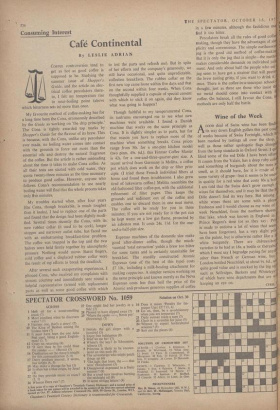Consuming Interest
Café Continental
By LESLI E ADRIAN COFFEE controversies tend to get as hot as good coffee is supposed to be. Studying the summer issue of Shopper's Guide, and the article on elec- trical coffee percolators there- in, I felt my temperature rise to near-boiling point (above which bitterness sets in) more than once.
My favourite method of coffee-making has for a long time been the Cona, erroneously described by the Guide as working on 'the drip principle.' The Cona is rightly awarded top marks by Shopper's Guide for the flavour of its brew. This is because, with the Cona, unlike any percolator ever made, no boiling water comes into contact with the grounds to force out more than the essential oils and destroy the natural fragrance of the coffee. But the article is rather misleading about the time it takes to make Cona coffee. As all their tests are started with cold water, they quote twenty-three minutes as the time necessary to produce good coffee. However, anyone who follows Cona's recommendation to use nearly boiling water will find that the whole process takes only five minutes.
My troubles started when, after four years (the Cona, though breakable, is much tougher than it looks), I had to replace one of the parts and found that the design had been slightly modi- fied. Several times recently the Cona, with its new rubber collar (it used to be cork), longer stopper and narrower outlet tube, has faced me with an embarrassing breakfast-time problem. The coffee was trapped in the top and the two halves were held firmly together by atmospheric pressure. Nothing would move. Burnt fingers, cold coffee and a displaced rubber collar were the result of my efforts to break the deadlock.
After several such exasperating experiences, I phoned Cona, who received my complaints with utmost courtesy and immediately sent round a helpful representative (armed with replacement parts as well as some good coffee with which to test the parts and refresh me). But in spite of her efforts and the company's generosity, we still have occasional, and quite unpredictable, coffeeless breakfasts. The rubber collar on the first new top came loose within five days and that on the second within four weeks. When Cona thoughtfully supplied a capsule of special cement with which to stick it on again, did they know what was going to happen?
Though faithful to my temperamental Cona, its tantrums encouraged me to see what new machines were available. I found a Danish machine that works on the same principle as Cona. It is slightly simpler as to parts, but for that reason you have to replace more of the machine when something breaks. Cona prices range from 38s. for a one-pint kitchen model (two pints, 49s. 6d.); this Finmar Coffee Master is 42s. for a one-and-three-quarter-pint size. A recent arrival from Germany is Melitta, a coffee pot which does work on the drip or filter prin- ciple. (I tried those French individual filters at home and found them troublesome. I also grew tired of lukewarm coffee.) Melitta resembles the old-fashioned filter coffee-pot, with the additional refinement of filter paper. This keeps the grounds and sediment out of the coffee and enables one to discard them in one neat move. The coffee will be ready for you in three minutes; if you are not ready for it the pot can be kept warm on a low gas flame, protected by an asbestos mat. It costs 24s. lid. for the one- and-a-half-pint size.
Espresso machines of the domestic size make good after-dinner coffee, though the much- vaunted 'total extraction' yields a brew too bitter for some tastes and is certainly unsuitable for breakfast. The sturdily constructed Atomic Espresso (one of the best of this type) costs £7 10s., including a milk-heating attachment for making cappucino. A simpler version working on the same principle and known merely as the Nova Espresso costs less than half the price of the Atomic and, produces generous supplies of coffee in a few minutes, although the fastidious m find it too bitter.
Percolators break all the rules of good coff making, though they have the advantages of si plicity and convenience. The simple earthenwa jug is the good old method of coffee-maki But it is only the jug that is simple—the meth makes considerable demands on individual jud ment. And only about half the people who use jug seem to have got a strainer that will preve the brew tasting gritty, if you want to drink it once. There is the coffee-in-a-saucepan school thought, just as there are those who insist t no metal should come into contact with coffee. On balance, I still favour the Cona, methods are only half the battle.






































 Previous page
Previous page